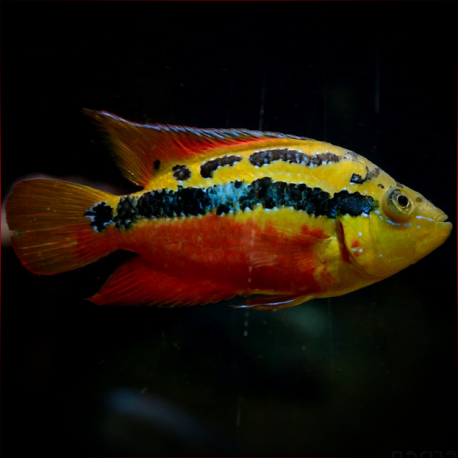More info
Datasheet
| Minimum Tank Size | 102 litres / 26.95 US gallons |
| Maximum Size | 15.2cm / 5.98inches |
| Temperature | 22°C / 71.60°F - 26°C / 78.80°F |
| Hardness | 8-15ºdH |
| pH | 6.5-8.0 |
General Description
The Salvin's Cichlid, scientifically known as Cichlasoma Salvini, is a species belonging to the Cichlidae family. These colorful fish have a reputation for aggression, especially during breeding, and are commonly found in the trade as vibrant additions to North and Central American aggression tanks. They are hardy and do not necessitate a large tank compared to some other cichlids of the region. This species, native to Eastern parts of Southern Mexico, Guatemala, and Belize, grows up to a maximum size of approximately 15.2 cm.
Aquarium Setup
Salvini cichlids thrive in a tank with a minimum size of 102 liters, preferring a sand substrate and ample hiding spots. When housing multiple Salvini or pairing them with other aggressive fish, providing numerous hiding places is crucial. While plants are welcomed, it is essential to create a large open area in the tank for swimming. The optimal water conditions for Salvini cichlids include a hardness of 8-15°dH, a pH range of 6.5-8.0, and a temperature between 22-26°C.
Behaviour
Primarily carnivorous, the Salvin's Cichlid feeds on aquatic invertebrates and small fish in its natural habitat. These fish are notably aggressive for their size and are territorial creatures that will prey on any fish they can fit into their mouths. It is advisable to house them with similarly aggressive, similarly sized North/Central American fish like Jack Dempseys to avoid conflict.
Feeding and Diet
Salvini cichlids are omnivorous and will consume a varied diet, including cichlid pellets, live and frozen foods, and occasionally vegetable/spirulina flakes or other plant matter. Feeding a high-quality cichlid pellet as a staple is recommended, supplemented with a diverse range of foods to ensure proper nutrition.
Reproduction & Dimorphism
Breeding Salvini cichlids can be challenging as they may take time to pair up. To obtain a true pair, it is suggested to raise multiple juveniles together to increase the likelihood of successful pairing. During the breeding process, the female will lay up to 500 eggs in various chosen spawning sites while both parents guard the eggs and fry, displaying significant parental care. Male Salvini exhibit more vivid coloration with pointed dorsal and anal fin tips, while females are distinguished by a central patch in their dorsal fins and a dark spot at the bottom of their gill plates.
Habitat and Distribution
Salvin's Cichlid habitats include the flowing central parts of rivers and tributaries in Eastern Southern Mexico, Guatemala, and Belize. They are known to spend a considerable amount of time hunting in these habitats, showcasing their natural behavior in the wild.

